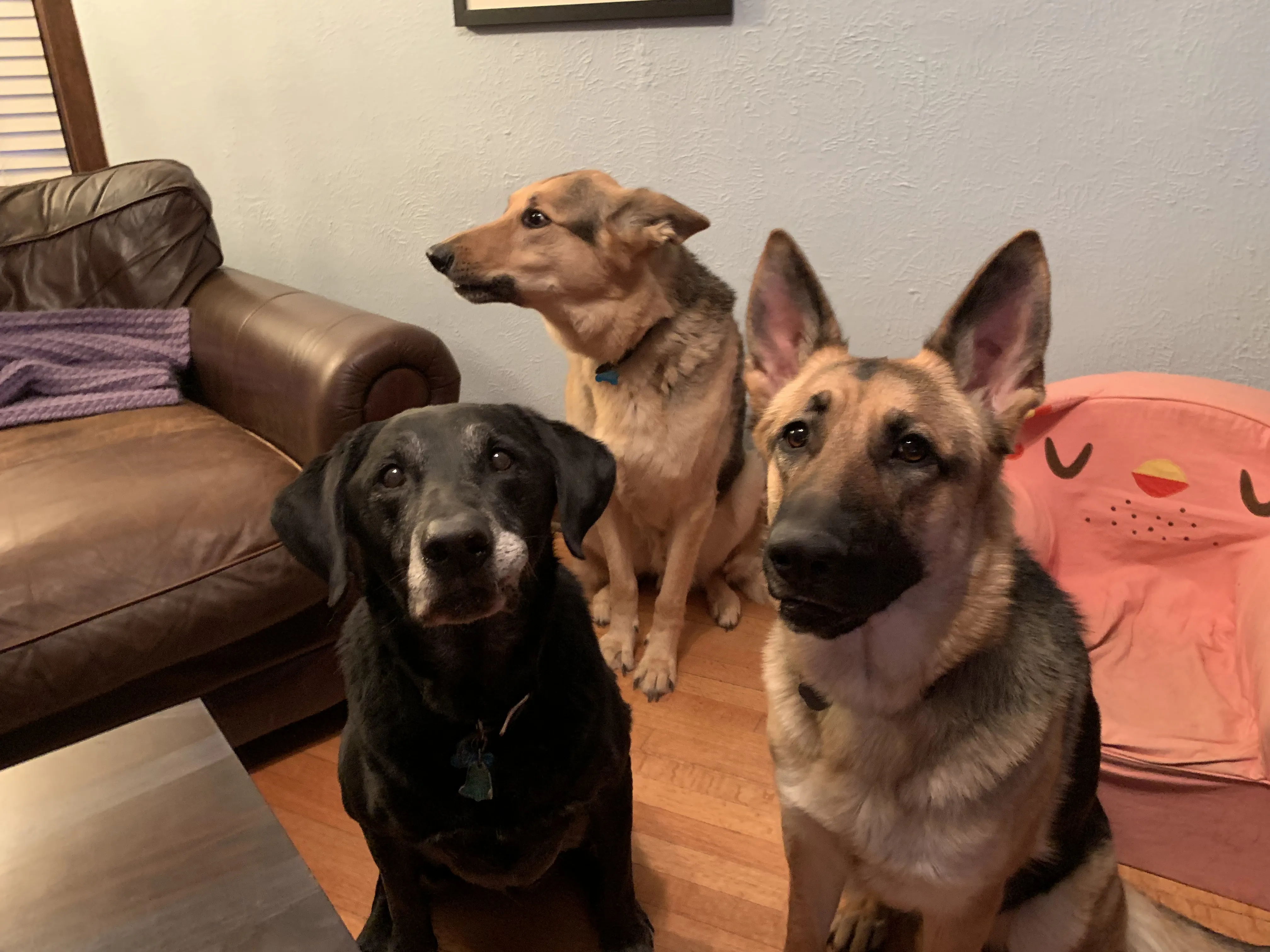Ensuring your dog reliably comes when called, especially when it’s time to head indoors, is a fundamental aspect of responsible pet ownership and a crucial safety measure. It builds trust, reinforces your bond, and can prevent dangerous situations. For instance, Evy, a lively 1-year-old German Shepherd, initially struggled with this command, highlighting a common challenge many dog guardians face. Understanding [understanding puppy behavior](https://dogcarestory.com/4-month-old-lab-puppy-behavior/) from a young age can lay a strong foundation for a well-behaved adult dog, making future training endeavors like indoor recall much smoother. This guide will explore why dogs might resist coming inside and provide proven strategies to cultivate a consistent and cheerful response.
 German Shepherd Evy with Black Lab Sully and German Shepherd Hogan in a grassy outdoor area, illustrating a dog reluctant to come inside when called.
German Shepherd Evy with Black Lab Sully and German Shepherd Hogan in a grassy outdoor area, illustrating a dog reluctant to come inside when called.
Understanding Why Your Dog Avoids Coming Inside
A dog’s reluctance to come inside when called isn’t necessarily defiance; it often stems from a combination of factors. Identifying the root cause is the first step toward finding a solution.
- Lack of Training or Clarity: Often, a dog’s reluctance stems from a lack of consistent training or unclear expectations. Just as mastering
[effective potty training](https://dogcarestory.com/best-way-to-potty-train-a-puppy/)requires patience and clear communication, so does teaching a reliable “come” command. If the dog doesn’t fully understand what’s expected, or if the command has been overused without positive reinforcement, they learn to ignore it. - Negative Associations: If coming inside has been associated with negative experiences, such as punishment, being scolded, or the immediate end of fun outdoor play, dogs can become hesitant. They may start to view entering the house as a consequence rather than a neutral or positive event.
- Outdoor Stimulation vs. Indoor Boredom: The outdoor environment is often far more stimulating for a dog than the indoors. With exciting smells, sounds, and space to explore, many dogs simply prefer to stay outside, especially if their indoor environment offers less engagement.
- Independence and Choice: Some dogs, especially independent breeds or those accustomed to extended unsupervised outdoor time, become used to making their own choices. They may simply be exercising their perceived autonomy by ignoring the call to come in.
- Anxiety or Fear: Less common, but sometimes anxiety or fear, such as a fear of the dark or loud indoor noises, can make a dog reluctant to enter the house. Observing your dog’s body language can help identify if fear is a contributing factor.
Proven Strategies for Reliable “Come Inside” Recall
Teaching your dog to reliably come inside when called requires consistency, positive reinforcement, and a deep understanding of canine motivation.
Avoid Ineffective Commands and Build Positive Associations
When a dog like Evy repeatedly ignores the “come” command, guardians often fall into the trap of repeating the command multiple times, often with increasing frustration. This inadvertently teaches the dog that the command is optional or doesn’t need to be acted upon immediately. Instead, focus on making coming inside a highly rewarding experience.
Always pair the command with something your dog loves, whether it’s a high-value treat, enthusiastic praise, or a favorite toy. The goal is for your dog to associate coming indoors with positive outcomes, transforming it from a chore into a joyful event.
Implement Passive Training and Reward Self-Initiated Returns
One of the most effective techniques is passive training, which allows your dog to “decide” to come inside on their own. Instead of calling them repeatedly, wait for a moment when they are naturally heading toward the door or glancing in your direction. The instant they move closer or enter, offer immediate praise and a reward. This method empowers the dog to learn through their own choices, reinforcing the idea that coming inside brings good things. This powerful positive reinforcement strategy ensures the dog associates the act with something desirable, speeding up habit formation.
Establish Clear Rules and a Leader-Follower Dynamic
Beyond direct recall training, establishing a healthy leader-follower dynamic can significantly improve your dog’s overall responsiveness and willingness to comply. By consistently enforcing rules, practicing [off-leash training](https://dogcarestory.com/how-do-you-train-a-dog-to-walk-off-leash/) exercises that demand impeccable recall, and rewarding desired behaviors through consistent passive training, your dog learns to see you as a reliable guide. This structured approach helps prevent behavioral challenges and fosters a stronger, more respectful relationship. Make sure all household members are on the same page with commands and expectations to avoid confusing your dog. Consistency is vital across all training, from teaching basic manners to [useful house training tips](https://dogcarestory.com/tricks-for-house-training-a-puppy/) or the “come inside” command.
Make Inside Time Engaging and Fun
Ensure the indoor environment is stimulating and enjoyable. Provide puzzle toys, engage in indoor games, or offer chew toys. If coming inside means the fun continues, your dog will be much more eager to comply. Gradually increase the duration your dog stays outside, calling them in before they become too engrossed in outdoor activities, setting them up for success.
Conclusion
Teaching your dog to reliably come inside when called is a journey that requires patience, consistency, and a positive approach. By understanding the reasons behind your dog’s reluctance, implementing positive reinforcement, and establishing a clear, respectful relationship, you can transform the “come inside” command into a joyful exchange. Remember, every successful recall builds trust and strengthens your bond. Embrace these strategies, and you’ll soon enjoy the peace of mind that comes with a dog who happily responds to your call, reinforcing the idea that [smart potty training tricks](https://dogcarestory.com/best-tricks-to-potty-train-a-puppy/) and reliable recall are cornerstones of a well-behaved companion.
